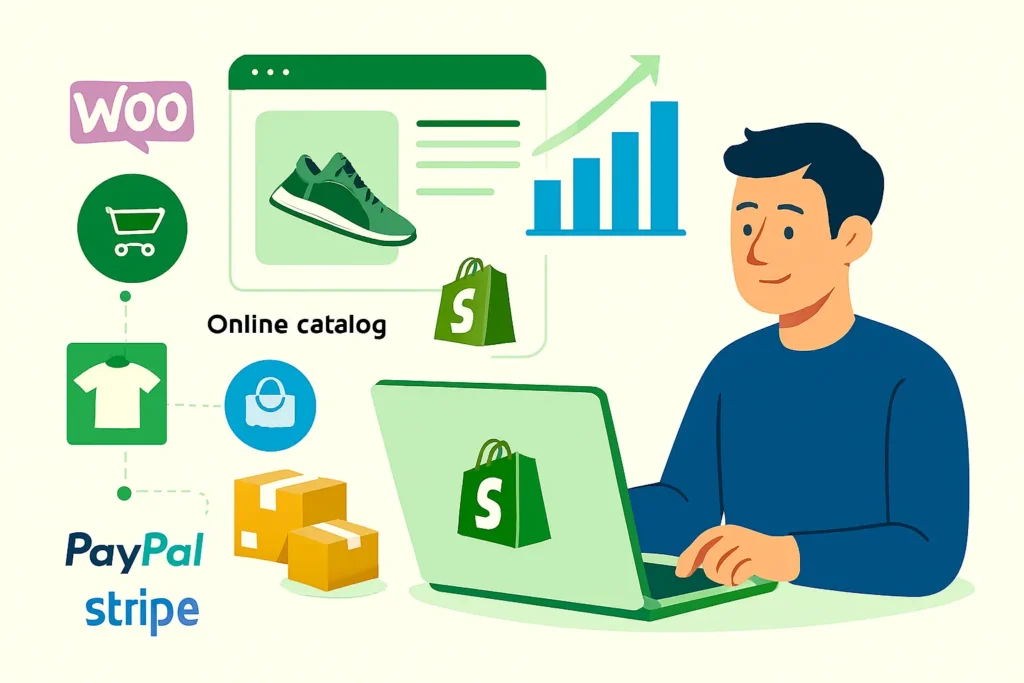Introduction
Starting an online store has never been easier, thanks to platforms like Shopify, WooCommerce, and other e-commerce solutions. Whether you want to sell physical products, digital items, or services, a well-planned online store can become a profitable business.
In this guide, we’ll walk you through how to create your own online store step by step, from picking a niche to launching your first product. By the end, you’ll know exactly how to open an online store that is ready to attract customers and generate sales.
Choosing Your Niche and Products
The first step in starting an online store is deciding what to sell and who to sell to. This involves:
- Researching trending products or underserved markets.
- Identifying your target audience’s needs and pain points.
- Validating product ideas with small test runs or surveys.
For example, if you’re interested in eco-friendly products, start by researching demand on platforms like Amazon, Etsy, and Google Trends. This ensures your store is focused and your marketing efforts are effective.
Picking the Right Platform
Choosing the right e-commerce platform is critical for long-term success:
- Shopify – Beginner-friendly, hosted solution, easy to scale, supports multiple payment gateways.
- WooCommerce (WordPress) – Flexible, highly customizable, requires hosting, best if you want control over design.
- BigCommerce / Wix / Squarespace – Alternatives with varying levels of features and cost.
Key considerations: transaction fees, ease of use, customization, payment integration, and app marketplace.
Common Questions Answered
Do I need technical skills to start an online store?
No. Platforms like Shopify and Wix provide drag-and-drop tools to set up your store without coding.
How much does it cost to start an online store?
Basic costs include domain (~$10/year), hosting (~$5–$20/month), and platform fees (~$29/month for Shopify). Additional costs include apps, marketing, and inventory.
Can I start without inventory?
Yes, dropshipping allows you to sell products without holding inventory. You partner with suppliers who ship directly to customers.
How long does it take to launch a store?
With Shopify or Wix, you can have a basic store live in 1–2 days. Full customization may take longer.
Which is better, Shopify or WooCommerce?
Shopify is easier for beginners; WooCommerce offers more control and lower ongoing fees but requires more setup.
Practical Steps to Launch Your Online Store
- Register Your Domain Name – Choose a short, brandable name relevant to your niche.
- Set Up Your E-Commerce Platform – Install Shopify/WooCommerce, select a theme, and configure settings.
- Add Products – Upload product images, write compelling descriptions, and set prices.
- Set Up Payment Gateways – Accept credit cards, PayPal, or other methods.
- Configure Shipping & Taxes – Define shipping zones, rates, and tax rules.
- Design Your Store – Customize colors, layout, and navigation to match your brand.
- Test Your Store – Place test orders to ensure everything works smoothly.
- Launch and Market – Use social media, email marketing, and SEO to drive traffic.
Comparisons or Alternatives
- Shopify vs WooCommerce – Shopify is simpler but less flexible; WooCommerce gives more control but requires hosting setup.
- Dropshipping vs Holding Inventory – Dropshipping is low-risk but lower margins; holding inventory requires capital but gives higher profit per sale.
- Free vs Paid Themes – Free themes are cost-effective, but premium themes often provide better customization and mobile optimization.
How 3PL Companies Can Help Your Online Store Grow
For online store owners, efficient order fulfillment is key to customer satisfaction and business growth. Partnering with a reliable 3PL (Third-Party Logistics) company can help you manage warehousing, inventory, packing, and shipping without the hassle of doing it all in-house. Companies like ShipBob, Deliverr, Rakuten Super Logistics, and Fulfillment by Amazon (FBA) offer scalable solutions for small and medium e-commerce businesses. Using a 3PL provider allows you to focus on marketing, product sourcing, and customer service, while ensuring that your orders are delivered quickly and accurately.
Conclusion
Starting an online store can be simple and profitable if you follow the right steps. By choosing a niche, picking a reliable platform, adding quality products, and marketing your store effectively, you can turn your online business idea into reality.
Whether you choose Shopify, WooCommerce, or another platform, the key is to start small, stay consistent, and refine your store over time. Now that you know how to open an online store step by step, it’s time to take action and launch your e-commerce journey.
